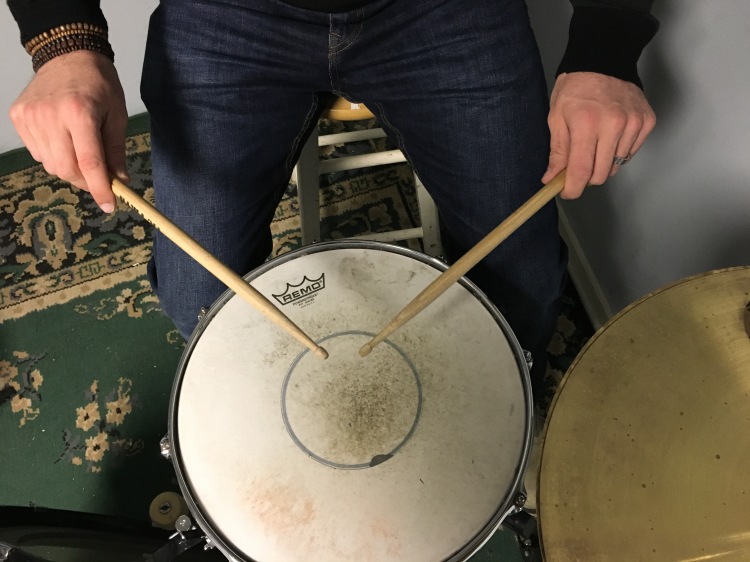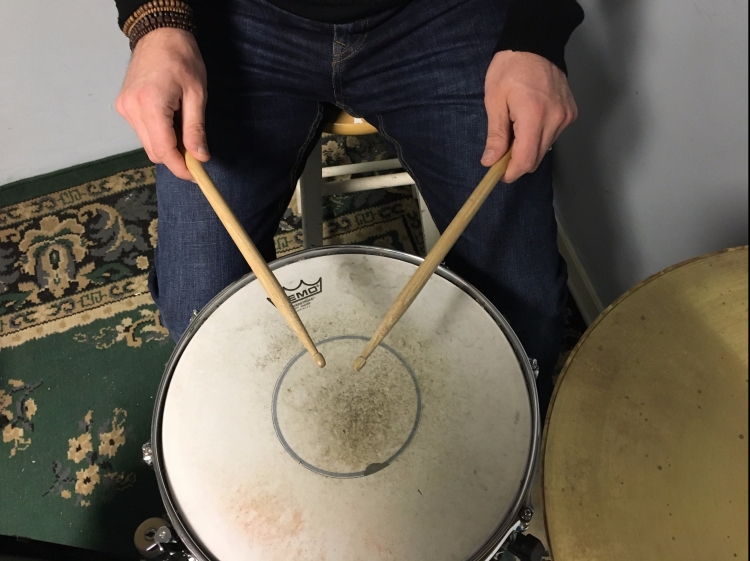There is very little we can do on the drums until we learn to hold our sticks correctly. Various grips have been introduced over the years, all with their own preferences and benefits. Many drummers begin playing with the grip that is most comfortable to them. Sometimes this means a grip that isn’t constructive to getting the most our of each stroke. Once your grip is solid, we can then begin exploring other types of techniques to improve things like control, speed, and dynamics. Let’s start with the most common grip:
Matched Grip
Matched grip includes a stance in which both hands match one another. This way, we can rely on the same grip and the same movement on each hand. Since they should both look and move the same way, this causes drummers to compare the two hands, sometimes very meticulously. While this is a good practice, it is important to remember that your left hand may operate slightly different from your right. So aim for a perfect match but don’t get hung up on subtle differences, as our bodies are all built differently. In general, it may feel a little weird exploring a grip that is not completely natural. So have patience as you develop your technique.
There is a very important word that is common to all grips – Fulcrum. Remember this from science class? The Meriam-Webster dictionary defines Fulcrum as “the support about which a lever turns”. In drumming, this means the point your fingers are secured to the stick to allow it to pivot. Every grip we discuss includes a fulcrum point.
German Grip
 This include a grip in which your thumb and pointer finger are forming a fulcrum point towards the bottom of the stick. If you pinch the stick, I always say you want about an inch sticking out the back of each hand. The remaining fingers will wrap around the stick and help control it when it’s in motion. Make sure the back of your hands are facing up, palms down. When your sticks meet in the middle of the drum, they will form a 90 degree angle, which will position your elbows out slightly. When the stick is in motion, remember that it’s important to use your wrists, not your arms.
This include a grip in which your thumb and pointer finger are forming a fulcrum point towards the bottom of the stick. If you pinch the stick, I always say you want about an inch sticking out the back of each hand. The remaining fingers will wrap around the stick and help control it when it’s in motion. Make sure the back of your hands are facing up, palms down. When your sticks meet in the middle of the drum, they will form a 90 degree angle, which will position your elbows out slightly. When the stick is in motion, remember that it’s important to use your wrists, not your arms.
American Grip
 This is very similar to German grip. You will hold your sticks exactly the same way, however this stance involves tucking your elbows in towards your body, which will cause your sticks to meet at more of a 45 degree angle in the center of the drum. The back of your hands will now be positioned outward a little more, but still facing up.
This is very similar to German grip. You will hold your sticks exactly the same way, however this stance involves tucking your elbows in towards your body, which will cause your sticks to meet at more of a 45 degree angle in the center of the drum. The back of your hands will now be positioned outward a little more, but still facing up.
French Grip
 While your hands are still matched, you will find yourself using your fingers a little more in order to move your stick with this grip. Here, you are bringing your sticks in so they are parallel to one another directly in front of your belly button. Where your palms are faced down for German and American grip, here they will actually face the opposite hand with your thumbs positioned on top of each stick. You will move your fingers to control the stick’s movement on both hands.
While your hands are still matched, you will find yourself using your fingers a little more in order to move your stick with this grip. Here, you are bringing your sticks in so they are parallel to one another directly in front of your belly button. Where your palms are faced down for German and American grip, here they will actually face the opposite hand with your thumbs positioned on top of each stick. You will move your fingers to control the stick’s movement on both hands.
Traditional Grip
 Back in the day, marching band drummers used to march with their drums on the side of their bodies. In order to get good touches on their drums, they had to play with their outside hand faced up and inside hand faced down. This style became heavily used in jazz drumming and is still very popular today. While the dominant hand leverages the same stance used in German grip, the less dominant hand holds the stick a bit differently. Put your hand out, palm up. Let the stick sit in the palm of your hand with the “balance point” in the crook between your thumb and pointer finger. This is going to be your fulcrum with traditional grip. You will then wrap your pointer finger around the stick, maintaining fairly loose contact. Next, curl the remaining fingers around the stick to keep control while the stick is in motion. These fingers will not play a huge role in actually directing the stick. To play, you are still using your wrists to move the stick up and down. There are various forms of traditional grip that involve greater use of the fingers, but that’s another post.
Back in the day, marching band drummers used to march with their drums on the side of their bodies. In order to get good touches on their drums, they had to play with their outside hand faced up and inside hand faced down. This style became heavily used in jazz drumming and is still very popular today. While the dominant hand leverages the same stance used in German grip, the less dominant hand holds the stick a bit differently. Put your hand out, palm up. Let the stick sit in the palm of your hand with the “balance point” in the crook between your thumb and pointer finger. This is going to be your fulcrum with traditional grip. You will then wrap your pointer finger around the stick, maintaining fairly loose contact. Next, curl the remaining fingers around the stick to keep control while the stick is in motion. These fingers will not play a huge role in actually directing the stick. To play, you are still using your wrists to move the stick up and down. There are various forms of traditional grip that involve greater use of the fingers, but that’s another post.
Drummers must all make decisions as to which grip is most suitable for them. This may be a stylistic preference or a general one. Regardless, use the direction above to get started and let me know if any questions come up while you play.

